Disclosure: Meeple Mountain received a free copy of this product in exchange for an honest, unbiased review. This review is not intended to be an endorsement.
Hello and welcome to ‘Focused on Feld’. In my Focused on Feld series of reviews, I am working my way through Stefan Feld’s entire catalogue. Over the years, I have hunted down and collected every title he has ever put out. Needless to say, I’m a fan of his work. I’m such a fan, in fact, that when I noticed there were no active Stefan Feld fan groups on Facebook, I created one of my own.
Today we’re going to talk about 2020’s The Castles of Tuscany, his 31st game.
The Castles of Tuscany (CoT) answers that age old question: “What if I’m dying to build up the countryside of some country other than France in just half the time it took me to get Burgundy sorted out?” In CoT, the players find themselves in 15th century Italy right smack dab in the middle of the Italian Renaissance. The lush, verdant hills are calling and just begging for someone to come along and spruce them up a bit by building a lot of stuff on top of them.
It’s the same basic setting and concept for Stefan Feld’s earlier masterpiece The Castles of Burgundy and I wouldn’t blame you for thinking that the two titles sound awfully similar. But as you will soon see, even though CoT shares some DNA with its predecessor, it’s a vastly different game that will challenge any preconceived notions that you might bring to the table. So, without further ado, let’s take a walk together through the Tuscan countryside.
Overview
Castles of Tuscany is played over 3 rounds, each consisting of a variable number of turns dependent entirely upon the actions of the players, with a scoring occurring at the end of each. In the game, each player will be managing their own region by means of tile drafting and tile placement.
When the game begins, the players’ Region boards are just a bunch of empty, differently colored hexagons. Between the players will be a selection of random, face up Region tiles that will eventually be placed onto their Region boards in order to score them points. Much like the Castles of Burgundy, each colored hex on the Region board can only accept a Region tile of the same color and each color Region tile placed scores in different ways or has a unique ability associated with it.
Unlike The Castles of Burgundy, the actions available to you on your turn are not dictated by the roll of a couple of dice, but by a handful of cards instead. These cards are drawn from a shared deck of randomly shuffled cards, each featuring a different type (i.e. color) of region. Drawing Region cards to add to your hand is one of the 3 possible actions you can perform on your turn. The second is taking a Region tile to put into your storage. The third option is placing a Region tile from your storage onto your Region board to score points as well as to perform the tile’s associated action.
Each player also begins the game with their own set of 21 Region tiles randomly sorted into 3 same-size stacks. As players take tiles to put into their storage, they will be replacing them with tiles drawn from these stacks. The first player to empty out their first stack triggers a scoring. Likewise for the first players emptying their second and third stacks. Players can also earn bonuses for being the first or second to cover up all of the hexagons of a single color on their Region boards.
The goal, of course, is to be the player that scores the most points by the game’s end.
Preparation
As I’ve already mentioned, each player begins the game with a Region board. To be more specific, each Region board is actually composed of several smaller tiles that are pushed together. Each player will be able to twist and turn these tiles to create a Region in a configuration of their choice. The game does impose some limitations on how offset the connected tiles can be, but there’s still a decent amount of customizability. Then each player places their double-sided castle tile onto 1 of the dark green regions.

Each player also receives a player board along with the Region tiles, 50/100 point marker, and scoring markers of their chosen color. The Region tiles are shuffled and placed face down onto the player board in 3 even sized stacks. The thinner scoring marker is placed onto the 0 space of the inner red ring of the scoring track and the other is placed onto the 0 of the outer green ring.
The Color Bonus tiles are set close by with their “1” sides facing up. Also kept close by is the deck of Region cards (shuffled and placed face down), the Yield cards (also shuffled and placed face down), the square bonus tiles, and the various resource bits. Then the neutral Region tiles are shuffled and placed face down in small stacks. 8 of these tiles are then drawn and placed face up.
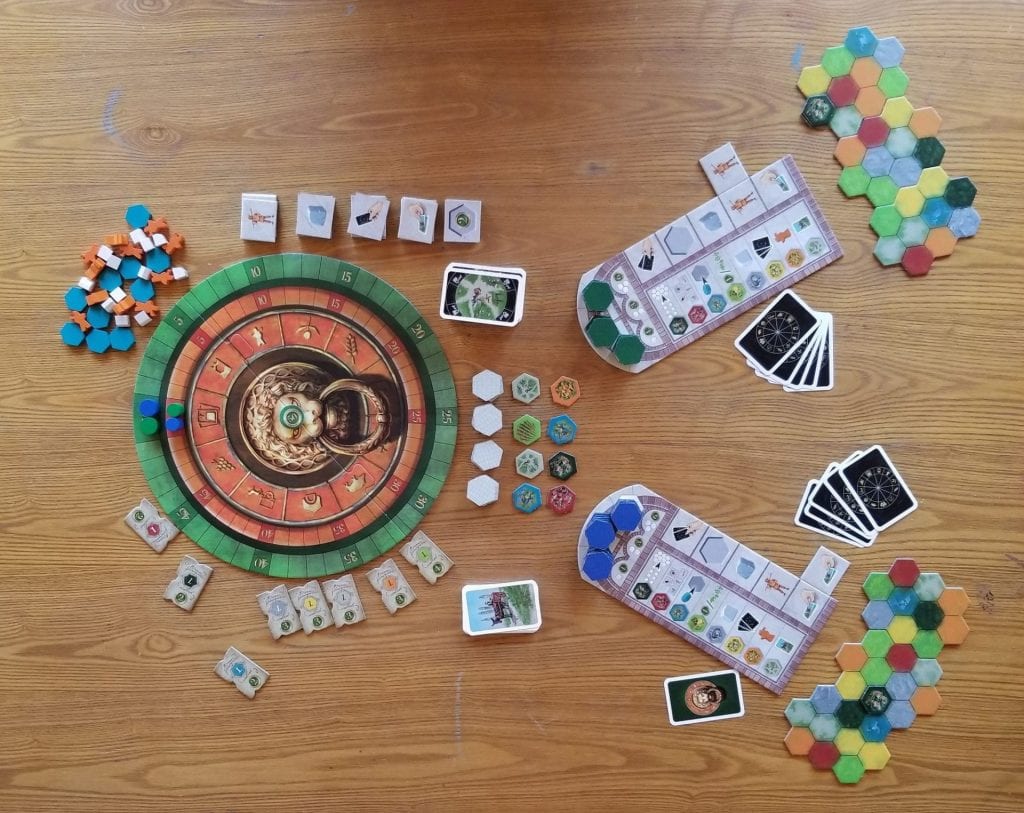
Finally, a start player is selected and will remain so for the rest of the game. Each player, in turn order, selects 1 square bonus tile to begin the game with and this is placed to the right of its match printed on the player board. Now you’re ready to begin playing The Castles of Tuscany.
Taking Action
The first action, drawing cards, is pretty self-explanatory. The player simply draws 2 cards from the Region card deck and adds them into their hand. The second action, take a tile, is almost as simple. You just select one of the neutral Region tiles that are available and place it into the tile storage area of your player board. If your storage is full, then you must discard the tile that already resides there. Then you will draw the top Region tile from your leftmost stack of personal Region tiles and place it face up as a replacement for the neutral tile you just selected.
The third action, playing a tile, requires a little more explanation.
In order to place a Region tile from your storage onto your Region board, you must be able to discard two Region cards from your hand which match the Region tile’s type. A grey tile, for instance, would necessitate you discarding 2 grey cards. Well, that’s almost true. As I said earlier, each Region tile has its own unique property and one of these, the orange tile, will provide you with workers which can be used as wild cards. So, you could play your grey tile using 2 workers or 1 worker and a grey card instead. In addition to the workers, a player can also discard 2 cards of the same type as a stand-in for a single card. This further extends the possibility of playing your grey tile using a worker and 2 yellow cards, for example. My point is, even though there is a decent amount of luck at play here hampering your ability to play tiles, there are multiple avenues that you can use in order to get them played.
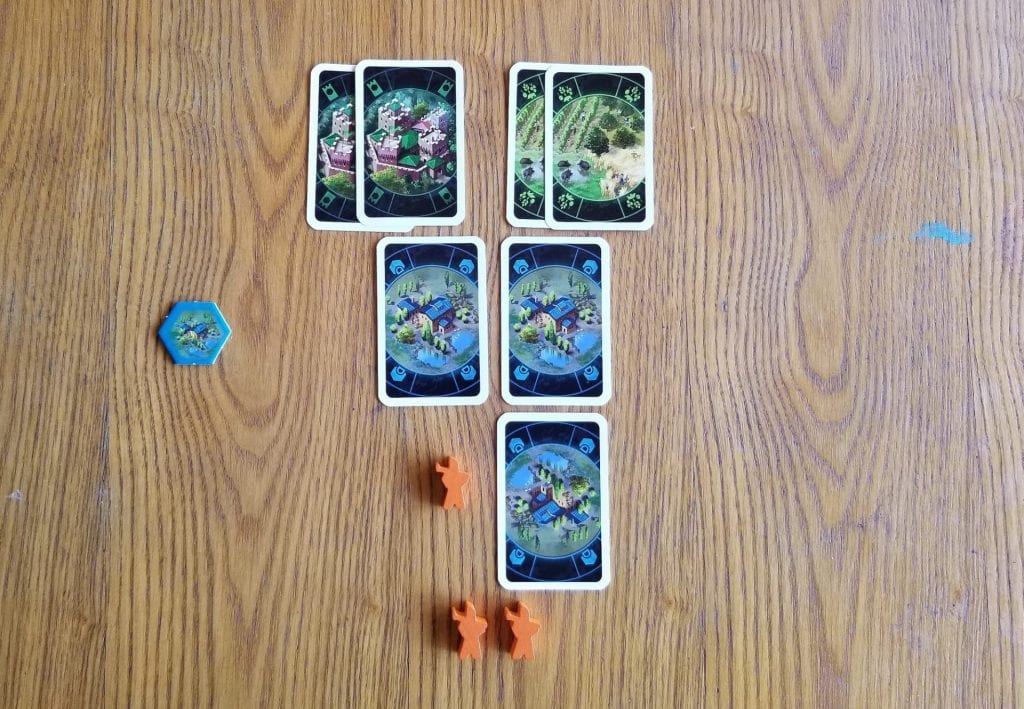
My only gripe here is about the role that luck plays in dictating which Region tiles are actually available to be drafted. You really have no method of exerting any control over which tiles are going to come up in the offering display. You only have a say in which tiles get removed. Then you say a prayer and flip over the next tile from your personal stack and pray it isn’t something that your opponents are going to snatch up like the blue, green, and red tiles (which are the most powerful tiles in the game). If the replacement tile happens to be the fifth tile of the same color in the display, then all 5 of them are removed from the game and replaced with 5 newly drawn neutral Region tiles. There will be plenty of times when you’re hoping that your tile selection doesn’t cause the display to get reset (so your opponents are left with the same lousy choices you had) and then your newly revealed tile causes the reset to happen revealing a juicy selection of useful tiles that you wish had been available to you.
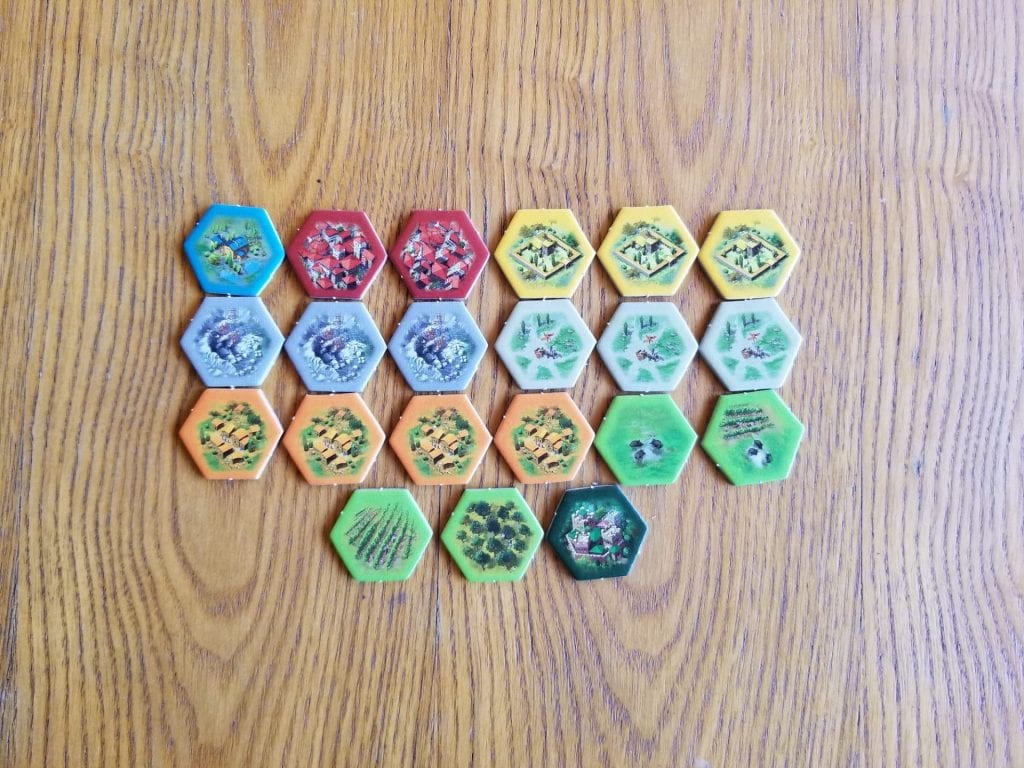
In short, it can feel somewhat disheartening to be forced to choose between nothing but bad options only to have your randomly revealed tile create good options for the other players. While it could be argued that every player is equally affected by unlucky draws, that doesn’t matter when you’re in the moment. When you’re in the moment, it just feels awful and that’s not much fun. Fortunately, The Castles of Tuscany moves along quickly enough that you won’t have long to dwell on it. The game will be over before you know it. This speed of play is one of The Castles of Tuscany’s greatest strengths.
Anyway, back to the Region tiles. As I’ve touched on several times now, each tile has its own unique action associated with it. The tile colors and their actions are:
Orange – as stated previously, placing an orange tile lets you take a worker from the supply.
Red – take any one of the available square bonus tiles and place it next to its matching illustration on your player board. These square bonus tiles generally make other actions more effective by doubling/tripling/quadrupling/etc. whatever their output is. For instance, the worker bonus tile gives you an additional worker for every worker bonus tile you own in addition to the 1 worker you’d get for placing an orange tile.
Blue – take a blue, wooden hex tile from the supply of resource bits and place it into your tile storage. This tile can now be used in place of any other tile. As an example: need a green tile? You can use this wooden blue one instead.
Light green – collect 1 victory point per agriculture type not in the same area (i.e. Region board hexes of the same color that touch each other). This doesn’t refer to all agriculture types in the game, rather it’s looking at the agriculture types that already exist in the area. So if you place a wheat tile in an area that already contains wheat, you’ll score 0 points. But if there are no wheat tiles present in that area, you’ll score 1 point.
Gray – take a marble block from the supply of resource bits. These can be traded in later on to perform additional actions on your turn. They are literally the only way to overcome the bad luck Resource tile draw I described earlier.
Yellow – draw 3 Region cards and add them to your hand.
Beige – draw a Yield card and immediately gain whatever bonus(es) are shown on the card. That card is then discarded.
Green – take any 1 of the 8 Region tiles on display and place it onto your Region board without paying any cards. This newly placed tile also grants you whatever its effect may be.
Your Efforts Are Rewarded
In The Castles of Tuscany a size 1 region filled in will always net you 1 point, a size 2 region will net you 3, and a size 3 region will net you 6 regardless of which round you complete them in. In the Castles of Burgundy, in addition to earning points based on the size of an area, you would also earn a bonus based on the round as well. Players typically try to fill in areas that are 1 or 2 hexes in size in the first few rounds because, in that game, the bonuses for filling in an area are higher during the early rounds. The Castles of Tuscany throws this out on its ear.
![]()
As you score points during the course of a round, your points will be accumulated on the green ring of the score track. When someone places the final Region tile from their personal tile stack into the central display, a scoring is triggered. When this happens, each player’s score on the green ring is transferred to the red ring. This means that the points you earn in the first round are going to get scored three times while those scored in the second will only get scored twice. This provides you with an impetus to score big as soon as you can.
Thoughts
A long time ago at the turn of this century I played Magic: the Gathering very heavily. My primary Magic companion at the time was my best friend. Shortly after arriving in Nashville, he and I began frequenting a local game store and competing in tournaments. He invested a lot of time and money into building an amazing deck and when he’d play with it during competitions, he would win handily.
And then I started beating him.
This sent him down a path of constantly tweaking and re-tweaking his deck until it bore little resemblance to the deck it had been previously, both in its mechanics and its ability to win. By messing with a perfectly good thing, he’d ruined it. Going into my first playthrough of The Castles of Tuscany knowing what I knew about it, my ultimate fear was that Stefan Feld had gone down that route that my friend had with his Magic deck. After playing my first game I was relieved that it wasn’t the case. At least not entirely.
For me, I liken The Castles of Tuscany to having gone your entire life eating M&Ms and then being handed a box of “Candy Coated Chocolate Snacks”. While the latter is perfectly serviceable, it’s a poor substitute for the real thing and only serves to remind you that you’d much rather be eating M&Ms. When I play The Castles of Tuscany, I find myself longing to play The Castles of Burgundy and that longing takes me out of the experience.
So, here’s what I’ll say about Tuscany. I have enjoyed my time with it. It’s easier to learn than Burgundy, plays faster than Burgundy, and it’s challenging in all the right ways. It’s a pretty good game to boot. But do you need Tuscany in your life if you already own Burgundy? I don’t think so. While different, there’s just not enough there to differentiate the two. If you’ve never played either, though, it comes down whether you want a longer game or a shorter one. If short and sweet is the way you roll, then Tuscany is the game for you.


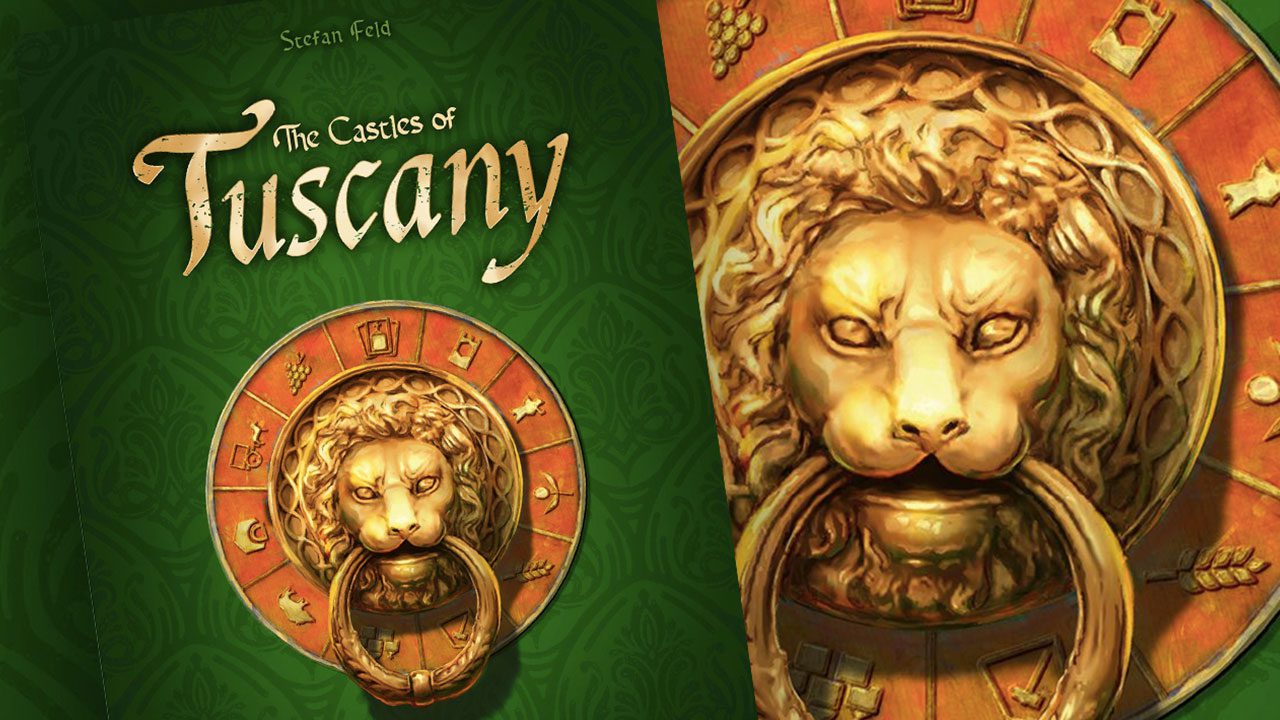




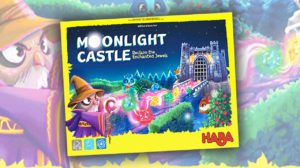




Add Comment